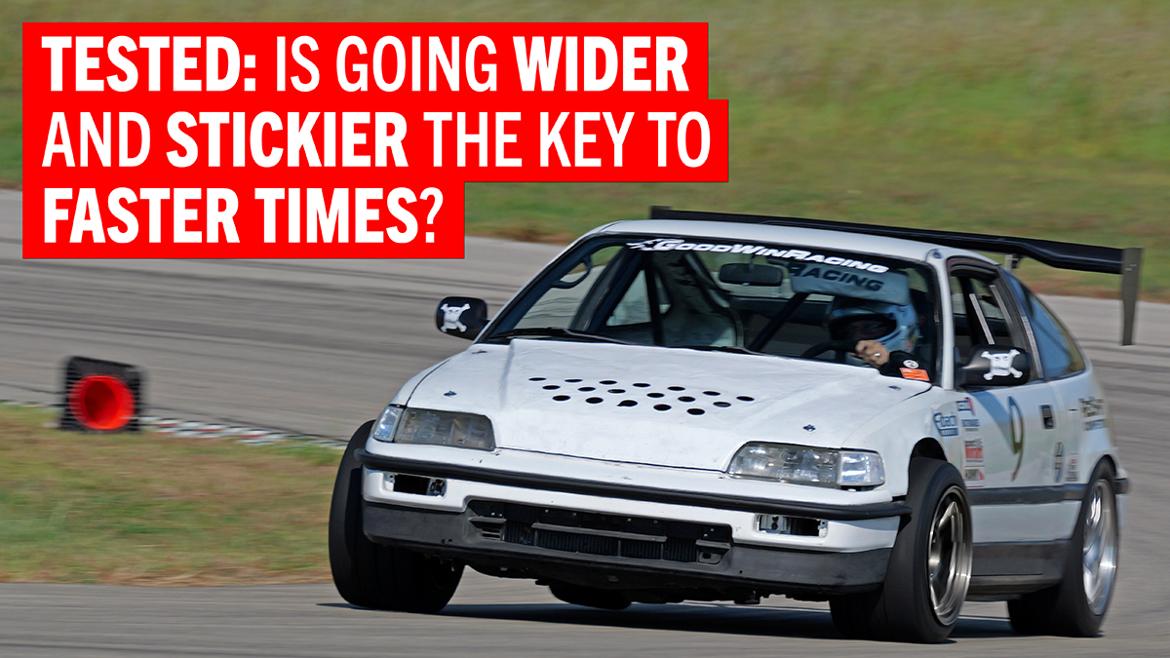Picking the best tire for motorsports is easy, right? Simply choose the widest fitment along with the stickiest rubber allowed by the rules. At least, that’s what the internet says.
If only that were the case. As we recently experienced, sometimes you need to make some seemingly unconventional comparisons to find the best option–which led us to this particular test.
Round 1
Test day dawned warm and sunny, with temps ranging from the mid 80s to mid 90s while we worked. Given the heat, we opted to run only four laps on each tire to reduce turnaround time. Swapping only the fronts further helped minimize heat soak. We did a few laps on some old scrubs to clean up the track and knock off the rust.
Nankang Sportnex CR-S 245/40R15
- Wheel: König Dekagram 15×10 ET25 with 6mm spacer (35 lbs. total)
- Fastest lap: 1:24.20
This combo was quite good, with only some mild understeer in long sweepers. It tracked straight and true over the bumps on the back straight. Oddly, it kept getting faster on each lap, with the final pass being the quickest. Looking at the data later, it was clear that the few warmup laps we’d done on the scrubs weren’t enough–the track was still evolving. In our haste to get going before the sun soaked the track, we’d compromised the first session a bit. Sigh.
Nankang Sportnex CR-S 275/35R15
- Wheel: König Dekagram 15×11 ET20 with 20mm spacer (38 lbs. total)
- Fastest Lap: 1:22.88
This setup was very quick. The extra width allowed for deeper braking on entry and earlier throttle application on exit. The handling was also better balanced. It did tramline excessively on the back straight, though, following every undulation of the bumpy surface.
Vitour Tempesta P1 285/30R17
- Wheel: König Hypergram 17×10 ET43 with 25mm spacer (46 lbs. total)
- Fastest lap: 1:23.17
While the 275mm Nankangs had given us three solid laps, the Vitour fell off a bit by the middle of the second lap. It then stabilized for the next two. Single-lap pace was not quite on par with the 275mm-wide Nankangs, though. Was this due to the narrower wheel width of 10 inches versus 11?
Data analysis showed the pace delta to be almost entirely under acceleration. The culprit? Rotating that substantially heavier wheel-and-tire package with less mechanical advantage due to taller OD. It was definitely quicker under combined loading, gaining back some of the deficit under trail braking.
Nankang Sportnex CR-S 245/40R15 retest
Bracketing our day with the 245mm Nankangs, we found a bit more speed this time around and earlier in the session. This felt more representative of the tire’s true pace. It also mirrored the lap time delta between it and the 275mm Nankang that we’d seen in our previous test on the Triple Threat ND Miata.
Round 2
Pondering the results while we waited for our BFGs to show up, two things bugged us: the flawed bracket due to insufficient warmup time and the tramlining of the 275mm Nankang. Was that feeling due to the extreme track width increase over the narrower 245? Big spacers can often make a big change in handling. Only one way to find out: another test.
This time we’d take a longer cleanup session and then use two pairs of 245s, one run as before and the other with the larger spacer mirroring the track width of the 275 as best we could. We’d also take note of any change in feel with the big spacer added.
Those results back up the first test almost perfectly. Notably, the big spacer made no discernible difference in either pace or feel. Case closed: The 275mm-wide Nankang Sportnex CR-S on an 11-inch-wide wheel was simply imitating an oil drum rolling on its side.
We also took the opportunity to get a read on relative performance of our new fastest setup versus what we had been running, shaved 225mm-wide Yokohama Advan A052s on 9-inch-wide wheels. That result was just shy of a full-second improvement. Nice!
Round 3
Once our BFGoodrich tires arrived and were given a heat cycle, we did one more round of testing to get another data point on the Rival S versus an equal-sized competitor. Turns out it’s not quite as quick as the Nankang Sportnex CR-S. We also tossed on the Yokohama Advan A052s again for one more shot and got the same results as before. Note that all of the wider setups were quicker than the narrower Yokohamas.
Conclusions
So, about that internet tribal wisdom of running the widest and stickiest: If we’d blindly followed it and chosen the big Vitour Tempesta P1s, we’d have missed out on our eventual winner, the 275/35R15 Nankang Sportnex CR-S on a 15×11-inch wheel. Turns out the weight and gearing effect overcame any potential grip advantage.
Would it have been different had the Vitour been mounted on 11-inch-wide wheels? Maybe. But at the moment, no 17×11-inch wheels exist in a 4×100 bolt pattern other than expensive custom ones.
But Vitour claims to have its own 275/35R15 size coming soon. Meanwhile, we’ll be running 275 Nankangs in competition–and as the available options change, we’ll be back to do more testing.

